The demand for neuromuscular transmission monitors in Japan is projected to reach USD 123.5 million by 2035, reflecting an absolute increase of USD 27.5 million over the forecast period. Starting at USD 96.0 million in 2025, the demand is expected to grow at a moderate CAGR of 2.6%. Neuromuscular transmission monitors are essential for assessing the neuromuscular function of patients, particularly in surgical settings where muscle relaxants are used. These devices play a critical role in ensuring patient safety by allowing healthcare professionals to monitor and control the use of muscle relaxants during anesthesia and surgery.
The demand for neuromuscular transmission monitors will be driven by the increasing number of surgeries, particularly in an aging population, the growing prevalence of chronic diseases that require surgical interventions, and the expanding use of anesthesia in both general and regional procedures. Advancements in medical technology and increased awareness of patient safety will contribute to the growing adoption of these devices in hospitals and surgical centers.
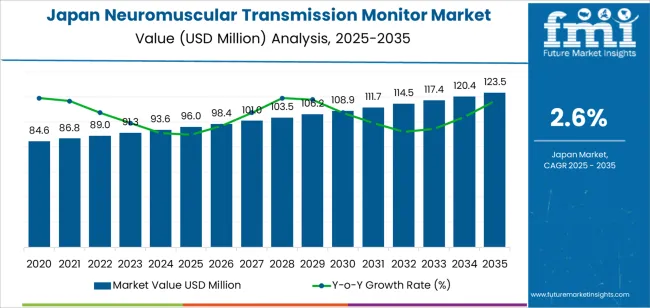
As the focus on patient-centered care intensifies, healthcare providers will increasingly invest in monitoring technologies to ensure more precise and personalized anesthesia management, driving steady demand growth over the forecast period. Moreover, integrating these devices with electronic health records (EHR) and other patient management systems will drive further adoption, making them an essential tool in modern surgical practices.
Between 2025 and 2030, the demand for neuromuscular transmission monitors in Japan is expected to grow from USD 96.0 million to USD 98.4 million, adding USD 2.4 million. This represents 8.8% of the total forecasted growth for the decade. During this phase, the growth will be steady and moderate, primarily driven by the increasing adoption of these monitors in hospitals and surgical centers. The demand during this period will be influenced by heightened awareness of the importance of neuromuscular function monitoring during anesthesia and the growing need for safer, more precise anesthesia management. The initial focus will be on upgrading existing systems to newer models with better functionality and integrating them into modernized healthcare infrastructure.
Between 2030 and 2035, the demand for neuromuscular transmission monitors will experience a more significant increase, expanding from USD 98.4 million to USD 123.5 million, adding USD 25.1 million. This accounts for 91.2% of the total forecasted growth for the decade. The sharp acceleration during this phase reflects the increasing integration of these devices into more healthcare settings, including outpatient clinics and smaller medical facilities, driven by advancements in technology, integration with EHR systems, and the growing adoption of personalized anesthesia protocols.
| Metric | Value |
|---|---|
| Japan Neuromuscular Transmission Monitoring Sales Value (2025) | USD 96.0 million |
| Japan Neuromuscular Transmission Monitoring Forecast Value (2035) | USD 123.5 million |
| Japan Neuromuscular Transmission Monitoring Forecast CAGR (2025 to 2035) | 2.6% |
The demand in Japan for neuromuscular transmission monitoring is increasing as hospitals and surgery centres place greater emphasis on patient safety during procedures involving muscle relaxants. These monitoring systems allow clinicians to assess the depth and recovery of neuromuscular blockade, reducing the risk of post‑operative complications such as residual paralysis. With Japan’s well‑established healthcare infrastructure and growing volume of surgical procedures, the adoption of monitoring devices is accelerating.
Japan’s ageing population and rising number of complex surgeries, including those in orthopedics and minimally invasive procedures, require precise monitoring tools. As surgical teams seek faster recovery profiles and shorter hospital stays, monitoring systems that offer objective data on neuromuscular function become essential. Device manufacturers are introducing modules with improved accuracy, connectivity, and ease of integration into operating‑room workflows, which supports uptake.
Regulatory guidelines and institutional standards increasingly recommend the use of neuromuscular transmission monitoring equipment as part of enhanced recovery protocols. Hospitals are integrating these systems into perioperative care to optimise muscle relaxant usage and enhance patient‑centred outcomes. Despite moderate growth rates, the demand for neuromuscular transmission monitoring in Japan is expected to increase steadily as surgical practices advance and monitoring becomes more standardised.
Demand is segmented by product, technology, and end user. By product, demand is divided into nerve stimulating devices/monitors, electrodes, and accessories, with nerve stimulating devices/monitors holding the largest share. In terms of technology, the industry is categorized into accelerography (ACG), electromyography (EMG), mechanomyography (MMG), and kinemyography (KMG), with accelerography (ACG) dominating. The industry is also segmented by end user, including hospitals, specialty clinics, and ambulatory surgical centers, with hospitals accounting for the largest share. Regionally, demand is divided into Kanto, Kinki, Chubu, Kyushu & Okinawa, Tohoku, and the Rest of Japan.
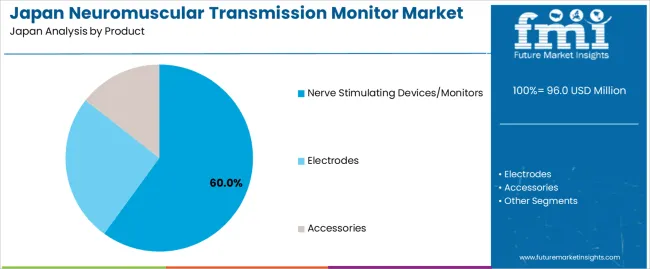
Nerve stimulating devices/monitors account for 60% of the demand for neuromuscular transmission monitors in Japan. These devices are crucial in surgical settings, particularly during anesthesia, where monitoring neuromuscular function ensures proper muscle relaxation and recovery. Nerve stimulating devices provide real-time feedback on the depth of muscle paralysis, allowing for precise control of anesthetic dosage and reducing the risk of complications such as residual neuromuscular block (RNMB).
The demand for nerve stimulating devices/monitors is driven by their ability to improve patient safety and recovery outcomes in both major and minor surgeries. They are especially valuable in hospitals, where surgical procedures are more complex and require advanced monitoring techniques. As patient safety and efficient recovery become more emphasized in Japan’s healthcare system, the adoption of nerve stimulating devices/monitors is expected to continue growing, particularly in hospitals and surgical centers that prioritize precision and minimal complications during and after surgery.
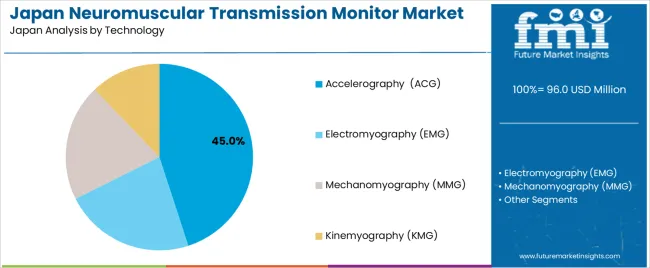
Accelerography (ACG) accounts for 45% of the demand for neuromuscular transmission monitors in Japan. ACG technology is favored for its ability to provide accurate and reliable measurements of muscle movement in response to nerve stimulation. It is highly effective for monitoring neuromuscular block during surgery, where precise control of muscle relaxation is required. ACG offers the advantage of being minimally invasive while providing consistent readings of muscle response, which makes it a preferred choice in both clinical and surgical environments.
The demand for ACG technology is growing due to its high sensitivity and precision, which are critical for anesthesia management in surgeries. Its non-invasive nature also reduces patient discomfort, further driving its adoption in clinical settings. As surgical procedures become more complex and the focus on patient safety increases, ACG technology will continue to dominate the industry, particularly in Japan’s hospitals and surgical centers where accurate neuromuscular monitoring is essential for positive patient outcomes.
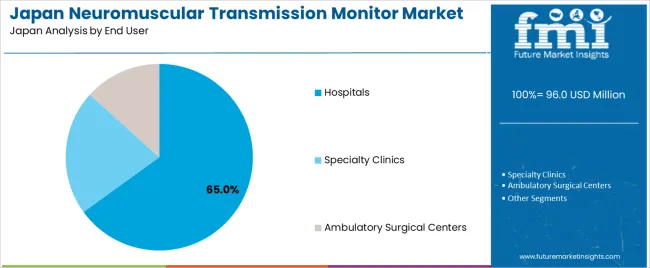
Hospitals account for 65% of the demand for neuromuscular transmission monitors in Japan. Hospitals are the primary setting for surgeries and intensive care, where accurate and continuous monitoring of neuromuscular function is essential. Nerve stimulating devices and monitors are integral in these settings, ensuring that muscle relaxation during surgery is controlled and that the patient recovers fully and safely after anesthesia.
In addition to routine surgeries, hospitals also deal with high-risk patients and complex procedures, which increases the need for advanced neuromuscular monitoring systems. The use of these devices in hospital settings improves patient outcomes by reducing complications such as delayed recovery from anesthesia or postoperative muscle weakness. As Japan continues to focus on improving surgical outcomes and patient safety, the demand for neuromuscular transmission monitors in hospitals will remain strong, making hospitals the largest end-user segment for these devices in the country.
Neuromuscular transmission monitors are increasingly used to ensure correct dosing and timely reversal of neuromuscular blocking agents. Key drivers include the country’s ageing population, increasing volume of surgical procedures, and growing enforcement of evidence‑based anesthesia protocols. Growth is tempered by high equipment costs, training and workflow integration challenges, and the slower uptake of advanced monitoring systems in smaller or regional hospitals.
Demand for neuromuscular transmission monitors in Japan is increasing as healthcare providers strive to enhance patient safety, particularly in high‑risk and elderly populations. The country’s aging demographic, along with rising surgical volumes, is contributing to a growing focus on minimizing postoperative complications such as residual neuromuscular blockade. These monitors allow for more precise management of neuromuscular blocking agents, ensuring faster recovery and reducing adverse effects. With the adoption of Enhanced Recovery After Surgery (ERAS) protocols, which emphasize quicker recovery and fewer complications, neuromuscular monitoring has become a critical part of the anesthesia regimen. Japan’s advanced healthcare system and quality‑conscious clinical environment, driven by academic hospitals and specialized surgical centers, are pushing early adoption of these technologies.
Technological innovations are accelerating the growth of neuromuscular transmission monitors in Japan by enhancing the performance, precision, and usability of these devices. Advancements in automatic calibration, electromyography (EMG) sensors, and wireless data transmission are making neuromuscular monitoring systems more accurate, faster, and easier to use. These innovations allow for real‑time feedback, enabling anesthesia teams to make quicker, more informed decisions regarding neuromuscular blockade. Integration with hospital information systems and electronic health records (EHR) is also becoming increasingly common, allowing for seamless data transfer and better patient monitoring across departments. These devices are becoming more user‑friendly, with features like touchscreens and intuitive interfaces, reducing the learning curve for medical staff.
High capital costs are a significant barrier, as advanced monitoring systems can be expensive, especially for smaller hospitals or outpatient centers with limited budgets. The integration of these devices into existing anesthesia workflows is another challenge, requiring hospitals to adapt their protocols and train staff on new technologies, which can be time‑consuming and costly. Industry penetration is uneven, with larger urban hospitals and specialized centers adopting the technology quickly, while smaller, regional facilities may face difficulties due to budget constraints or limited resources. Uncertainty around reimbursement structures and the perceived return on investment for these devices can slow adoption, as hospitals may hesitate to invest in new technologies without clear financial incentives.
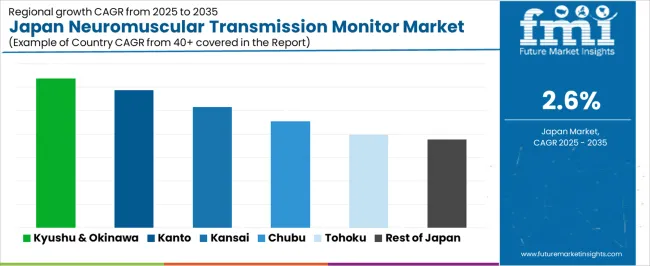
| Region | CAGR (%) |
|---|---|
| Kyushu & Okinawa | 3.2% |
| Kanto | 2.9% |
| Kinki | 2.6% |
| Chubu | 2.3% |
| Tohoku | 2.0% |
| Rest of Japan | 1.9% |
The demand for neuromuscular transmission monitors in Japan is growing across all regions, with Kyushu & Okinawa leading at a 3.2% CAGR. This growth is driven by increasing adoption in surgical and intensive care units. Kanto follows with a 2.9% CAGR, influenced by Tokyo’s advanced medical infrastructure. Kinki shows a 2.6% CAGR, with growing use in clinical settings. Chubu sees a 2.3% CAGR, driven by steady adoption in hospitals and healthcare centers. Tohoku and the Rest of Japan experience more moderate growth at 2.0% and 1.9%, respectively, due to ongoing improvements in medical technology and healthcare access.
Kyushu & Okinawa is experiencing the highest growth in demand for neuromuscular transmission monitors in Japan, with a 3.2% CAGR. The region’s growth is driven by the increasing focus on advanced patient care, particularly in hospitals and surgical centers where accurate anesthesia monitoring is crucial. Kyushu, including Fukuoka, is home to several modern hospitals and medical centers that are adopting advanced technologies to enhance patient outcomes, especially in high-risk surgeries.
Okinawa, which has historically had less access to high-tech medical equipment, is also seeing improvements in healthcare infrastructure. As more facilities adopt state-of-the-art monitoring systems to improve anesthesia management and prevent complications, the demand for neuromuscular transmission monitors continues to grow. The regional push for better healthcare access and the government’s focus on modernizing medical practices in Kyushu & Okinawa ensures that demand for these devices will remain strong.
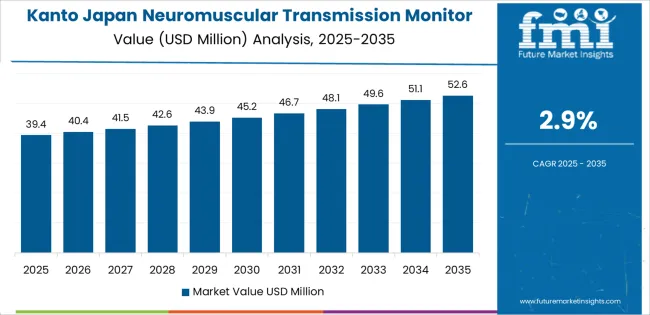
Kanto is experiencing steady growth in demand for neuromuscular transmission monitors, with a 2.9% CAGR. The region benefits from its extensive healthcare infrastructure, particularly in Tokyo, where medical institutions and universities lead in adopting cutting-edge technologies. The high concentration of hospitals, surgical centers, and research institutions in Kanto drives the demand for neuromuscular monitors, especially for anesthesia management during complex surgeries.
As awareness of the importance of precise neuromuscular monitoring in improving surgical outcomes grows, Kanto remains at the forefront of the demand for these devices. Hospitals and healthcare providers in the region prioritize patient safety and efficiency, driving the adoption of technologies like neuromuscular transmission monitors. With Kanto's strong emphasis on medical innovation and high-tech healthcare services, demand for these devices will continue to rise steadily, ensuring that the region remains a key contributor to the growth of neuromuscular transmission monitoring in Japan.
Kinki is experiencing steady demand for neuromuscular transmission monitors, with a 2.6% CAGR. The region, including Osaka and Kyoto, is home to many major hospitals and healthcare centers that prioritize advanced technologies to ensure patient safety, especially during surgeries that require precise anesthesia management. Kinki’s growing focus on high-quality patient care and the increasing number of complex surgical procedures are contributing to the rise in demand for these monitors.
The region’s well-established medical infrastructure and academic institutions also play a significant role in the adoption of neuromuscular transmission monitoring systems. Kinki’s emphasis on improving healthcare standards and embracing new technologies ensures continued growth in the use of these devices, particularly in critical care and surgical settings. As more hospitals incorporate advanced monitoring technologies into their practices, the demand for neuromuscular transmission monitors in Kinki is expected to continue growing steadily.
Chubu is seeing moderate growth in the demand for neuromuscular transmission monitors, with a 2.3% CAGR. The region’s growth is driven by increasing adoption in major cities like Nagoya, where hospitals and surgical centers are focusing on enhancing patient care with advanced anesthesia monitoring systems. As the demand for precise monitoring of neuromuscular function rises during surgeries, more medical centers in Chubu are integrating these technologies to improve safety and minimize complications.
Chubu’s moderate growth rate is also supported by the expanding healthcare infrastructure, which includes regional hospitals upgrading their technologies and increasing patient care capabilities. While not as fast-growing as Kanto or Kyushu & Okinawa, Chubu is expected to see steady adoption of neuromuscular transmission monitors, driven by the region’s focus on improving clinical outcomes, particularly in high-risk surgeries and critical care environments.
Tohoku is experiencing moderate growth in demand for neuromuscular transmission monitors, with a 2.0% CAGR. The region’s growth is influenced by improvements in healthcare infrastructure and a rising focus on patient safety, particularly in hospitals and surgical facilities. While not as advanced as Kanto or Kyushu & Okinawa, Tohoku is steadily adopting advanced medical technologies, including neuromuscular transmission monitors, to improve the quality of care during surgeries.
Tohoku’s healthcare providers are increasingly adopting technologies to ensure safe anesthesia management and reduce risks associated with surgeries. As the region continues to modernize its healthcare facilities and increase access to high-quality medical care, the demand for these monitoring devices will continue to rise. The government’s ongoing investment in healthcare infrastructure and the gradual shift toward more advanced pain-management and anesthetic monitoring systems ensure that demand for neuromuscular transmission monitors in Tohoku will remain steady.
The Rest of Japan is seeing slower growth in demand for neuromuscular transmission monitors, with a 1.9% CAGR. The region’s growth is primarily driven by gradual improvements in healthcare access, as smaller hospitals and clinics increasingly incorporate advanced medical technologies. The rising awareness of the importance of neuromuscular monitoring in surgery and critical care is encouraging more healthcare facilities in rural areas to adopt these devices.
As medical standards improve across the region and healthcare providers seek to enhance patient care, the demand for neuromuscular transmission monitors is expected to grow. While the pace of growth in the Rest of Japan is slower compared to urban centers like Kanto, the steady increase in healthcare modernization and the adoption of patient safety protocols will contribute to continued demand for these devices, albeit at a more moderate pace.
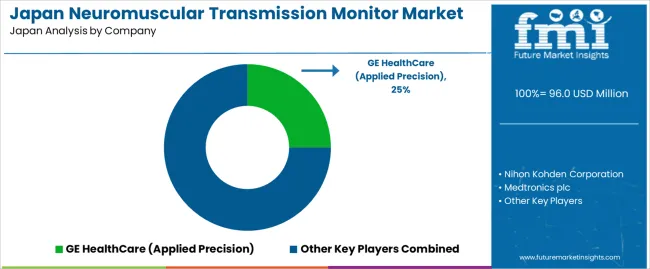
Demand for neuromuscular transmission monitoring in Japan is rising as hospitals intensify focus on anesthesia safety, precision surgical outcomes, and enhanced recovery protocols. With an aging population and increasing surgical volumes across specialty areas such as orthopedics, cardiovascular, and neurosurgery, Japanese medical facilities are adopting advanced monitoring systems to detect and manage neuromuscular blockade effectively.
Within the Japanese demand landscape, GE Healthcare (Applied Precision) holds a 25.0% share, demonstrating its strong foothold in the industry through comprehensive monitoring systems and hospital‑scale distribution. Other key players are Nihon Kohden Corporation, Medtronic plc, Drägerwerk AG & Co. KGaA, and Koninklijke Philips N.V., each offering integrated platforms or stand‑alone monitors that align with Japan’s rigorous clinical standards and perioperative care requirements.
The main drivers of demand include increased adoption of objective neuromuscular monitoring, interest in reducing postoperative complications, and the transition toward sophisticated anesthesia management in Japanese hospitals. Factors such as high acquisition cost, need for clinician training, and integration with existing OR equipment may limit rapid uptake in some settings. The outlook for neuromuscular transmission monitoring in Japan appears favorable as surgical volumes grow, technology advances, and providers prioritize patient safety and operational efficiency.
| Items | Values |
|---|---|
| Quantitative Unit | USD million |
| Product Type | Nerve Stimulating Devices/Monitors, Electrodes, Accessories |
| Technology | Accelerography (ACG), Electromyography (EMG), Mechanomyography (MMG), Kinemyography (KMG) |
| End User | Hospitals, Specialty Clinics, Ambulatory Surgical Centers |
| Regions Covered | Kyushu & Okinawa, Kanto, Kinki, Chubu, Tohoku, Rest of Japan |
| Key Players Profiled | GE HealthCare (Applied Precision), Nihon Kohden Corporation, Medtronics plc, Drägerwerk AG & Co. KGaA, Koninklijke Philips N.V. |
| Additional Attributes | Dollar sales by product type, technology, end user, and regional distribution with a focus on healthcare applications and medical centers |
The global demand for neuromuscular transmission monitor in Japan is estimated to be valued at USD 96.0 million in 2025.
The demand for neuromuscular transmission monitor in Japan is projected to reach USD 123.5 million by 2035.
The demand for neuromuscular transmission monitors in Japan is expected to grow at a 2.6% CAGR between 2025 and 2035.
The key product types are nerve-stimulating devices/monitors, electrodes and accessories.
In terms of technology, the accelerography (ACG) segment is expected to command 45.0% share in the demand for neuromuscular transmission monitors in Japan in 2025.






Our Research Products

The "Full Research Suite" delivers actionable market intel, deep dives on markets or technologies, so clients act faster, cut risk, and unlock growth.

The Leaderboard benchmarks and ranks top vendors, classifying them as Established Leaders, Leading Challengers, or Disruptors & Challengers.

Locates where complements amplify value and substitutes erode it, forecasting net impact by horizon

We deliver granular, decision-grade intel: market sizing, 5-year forecasts, pricing, adoption, usage, revenue, and operational KPIs—plus competitor tracking, regulation, and value chains—across 60 countries broadly.

Spot the shifts before they hit your P&L. We track inflection points, adoption curves, pricing moves, and ecosystem plays to show where demand is heading, why it is changing, and what to do next across high-growth markets and disruptive tech

Real-time reads of user behavior. We track shifting priorities, perceptions of today’s and next-gen services, and provider experience, then pace how fast tech moves from trial to adoption, blending buyer, consumer, and channel inputs with social signals (#WhySwitch, #UX).

Partner with our analyst team to build a custom report designed around your business priorities. From analysing market trends to assessing competitors or crafting bespoke datasets, we tailor insights to your needs.
Supplier Intelligence
Discovery & Profiling
Capacity & Footprint
Performance & Risk
Compliance & Governance
Commercial Readiness
Who Supplies Whom
Scorecards & Shortlists
Playbooks & Docs
Category Intelligence
Definition & Scope
Demand & Use Cases
Cost Drivers
Market Structure
Supply Chain Map
Trade & Policy
Operating Norms
Deliverables
Buyer Intelligence
Account Basics
Spend & Scope
Procurement Model
Vendor Requirements
Terms & Policies
Entry Strategy
Pain Points & Triggers
Outputs
Pricing Analysis
Benchmarks
Trends
Should-Cost
Indexation
Landed Cost
Commercial Terms
Deliverables
Brand Analysis
Positioning & Value Prop
Share & Presence
Customer Evidence
Go-to-Market
Digital & Reputation
Compliance & Trust
KPIs & Gaps
Outputs
Full Research Suite comprises of:
Market outlook & trends analysis
Interviews & case studies
Strategic recommendations
Vendor profiles & capabilities analysis
5-year forecasts
8 regions and 60+ country-level data splits
Market segment data splits
12 months of continuous data updates
DELIVERED AS:
PDF EXCEL ONLINE
Demand Signal Repository Solutions Market Size and Share Forecast Outlook 2025 to 2035
Demand Side Management Market Size and Share Forecast Outlook 2025 to 2035
Demand Response Market Analysis - Size, Share, and Forecast Outlook 2025 to 2035
North America Shipping Supplies Market Trends – Innovations & Growth 2024-2034
Demand of Kozani Saffron in Greece Analysis - Size, Share & Forecast 2025 to 2035
Demand of No-acid Whey Strained Dairy Processing Concepts in European Union Size and Share Forecast Outlook 2025 to 2035
Demand for Bronte Pistachio in Italy Analysis - Size, Share & Forecast 2025 to 2035
Glycine Soja (Soybean) Seed Extract Market Size and Share Forecast Outlook 2025 to 2035
Demand and Trend Analysis of Yeast in Japan - Size, Share, and Forecast Outlook 2025 to 2035
Demand of Pistachio-based desserts & ingredients in France Analysis - Size, Share & Forecast 2025 to 2035
Western Europe Men’s Skincare Market Analysis – Forecast 2023-2033
Demand and Trends Analysis of Stevia in Japan Size and Share Forecast Outlook 2025 to 2035
Japan Women’s Intimate Care Market Trends – Growth & Forecast 2024-2034
Demand and Trend Analysis of Fabric Stain Remover in Korea Size and Share Forecast Outlook 2025 to 2035
Demand and Sales Analysis of Paper Cup in Korea Size and Share Forecast Outlook 2025 to 2035
Demand and Sales Analysis of Paper Cup in Western Europe Size and Share Forecast Outlook 2025 to 2035
Demand of MFGM-enriched Powders & RTDs in European Union Size and Share Forecast Outlook 2025 to 2035
Demand and Sales Analysis of Paper Cup in Japan Size and Share Forecast Outlook 2025 to 2035
Demand and Trend Analysis of Avocado Oil in Western europe Size and Share Forecast Outlook 2025 to 2035
Vanilla Bean Industry Analysis in Japan Size and Share Forecast Outlook 2025 to 2035

Thank you!
You will receive an email from our Business Development Manager. Please be sure to check your SPAM/JUNK folder too.
Chat With
MaRIA